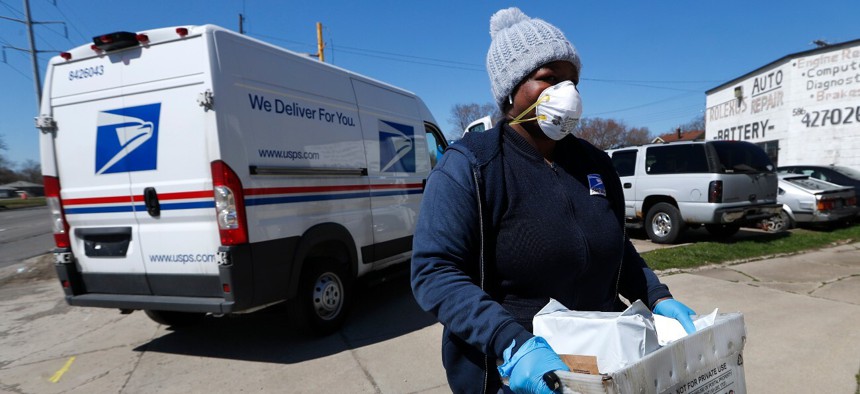
AP file photo
How USPS Came to Overstate Its Pandemic Fallout
The pandemic's impact on the Postal Service has not been nearly as dramatic as the agency once feared.
The U.S. Postal Service used its “professional judgment” in predicting massive financial losses as a result of the pandemic that in reality never played out as dramatically as the mailing agency had expected, a watchdog has found.
The processes USPS used to make its calculations were inherently ad hoc and based on assumptions with little historic precedent, the agency’s inspector general found in a report on Wednesday. That led postal management to forecast precipitous declines in mail and package volume and corresponding calamitous drops in revenue. To date, however, USPS has earned more revenue than the same period before the COVID-19 pandemic began.
The better-than-expected results were driven in large part by skyrocketing package business as ecommerce sales grew while Americans remained at home, though regular mail volume has not declined as much as management had anticipated. Mail volume was down 27% in April 2020 compared to April 2019, but the declines were less severe in the months that followed. At the outset of the pandemic, the Postal Service projected its fiscal 2020 revenue could dip to as low as $67 billion. In reality, it took in more than $73 billion.
“Although no organization could accurately estimate the full impact of the pandemic, these trends suggest mail and package volume and revenue may not be permanently impacted to the extent that the Postal Service projected in its scenarios,” the inspector general said. The watchdog added that because the pandemic is ongoing, it is still too soon to make any definitive conclusions.
The IG faulted USPS for failing to document its processes for making its assumptions. Postal management spoke to its largest customers who said they expected to use the mail less as a result of the pandemic, for example, which affected the agency’s projections. It never recorded its takeaways from those conversations or indicated how they impacted its forecasts. Management was “unable to provide a documented methodology that included specific steps and assumptions they applied to determine volume projections,” the IG said.
In April, the Postal Service asked Congress for $75 billion in relief, citing the effects of the pandemic. Postal officials said at the time the agency was dealing with liquidity issues that would soon impact its ability to operate, though they later revised those estimates. Some members of Congress cited the agency’s turnaround in suggesting its management was being overdramatic with its requests. To date, lawmakers have provided $10 billion, though Postmaster General Louis DeJoy has indicated he will seek further investment in the near future.
Postal management has stressed that it does not expect its good fortune on package volume to continue as Americans begin to feel safer returning to stores. Growth in package volume also comes with its own set of problems, as it is more labor intensive and therefore costlier relative to regular mail. Despite the bit of positive news, USPS remains in a precarious financial situation. And while its finances have not suffered as much as anticipated, postal operations have suffered significantly as employee unavailability and other factors have created unprecedented mail delays.
The auditors said that going forward, USPS should create a process outlining specific steps it will take to make assumptions in the event of a catastrophic or unanticipated event. Management said it has already established a process to use econometric models and qualitative information during such events, but agreed to make a more formal checklist for its forecasts. It also agreed with the IG’s recommendation to issue an after-action report following the conclusion of the pandemic to evaluate its own actions.







